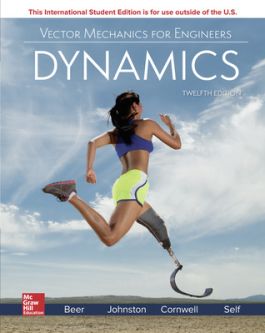Vector Mechanics for Engineers ISE
12th Edition
1260289699
·
9781260289695
© 2019 | Published: January 29, 2018
A primary objective in a first course in mechanics is to help develop a student's ability first to analyze problems in a simple and logical manner, and then to apply basic principles to their solutions. A strong conceptual understanding of these basi…
Read More
After you purchase your eBook, you will need to download VitalSource Bookshelf, a free app. Then login or create an account and enter the code from your order confirmation email to access your eBook.
- Note: the eBook does not include access to Connect
- Access the eBook anytime, anywhere: online or offline
- Create notes, flashcards and make annotations while you study
- Full searchable content: quickly find the answers you are looking for
11) Kinematics of Particles
12) Kinetics of Particles: Newton's Second Law
13) Kinetics of Particles: Energy and Momentum Methods
14) Systems of Particles
15) Kinematics of Rigid Bodies
16) Plane Motion of Rigid Bodies: Forces and Accelerations
17) Plane Motion of Rigid Bodies: Energy and Momentum Methods
18) Kinetics of Rigid Bodies in Three Dimensions
19) Mechanical Vibrations
Appendix Fundamentals of Engineering Examination
A primary objective in a first course in mechanics is to help develop a student's ability first to analyze problems in a simple and logical manner, and then to apply basic principles to their solutions. A strong conceptual understanding of these basic mechanics principles is essential for successfully solving mechanics problems. This edition of Vector Mechanics for Engineers will help instructors achieve these goals. Continuing in the spirit of its successful previous editions, this edition provides conceptually accurate and thorough coverage together with a significant refreshment of the exercise sets and online delivery of homework problems to your students.
The 12th edition has new case studies and enhancements in the text and in Connect. The hallmark of the Beer-Johnston series has been the problem sets.This edition is no different. Over 650 of the homework problems in the text are new or revised. One of the characteristics of the approach used in this book is that mechanics of particles is clearly separated from the mechanics of rigid bodies. This approach makes it possible to consider simple practical applications at an early stage and to postpone the introduction of the more difficult concepts. Additionally, Connect has over 100 Free-Body Diagram Tool Problems and Process-Oriented Problems.
McGraw-Hill Education's Connect, is also available. Connect is the only integrated learning system that empowers students by continuously adapting to deliver precisely what they need, when they need it, how they need it, so that class time is more effective. Connect allows the professor to assign homework, quizzes, and tests easily and automatically grades and records the scores of the student's work. Problems are randomized to prevent sharing of answers an may also have a "multi-step solution" which helps move the students' learning along if they experience difficulty.
The 12th edition has new case studies and enhancements in the text and in Connect. The hallmark of the Beer-Johnston series has been the problem sets.This edition is no different. Over 650 of the homework problems in the text are new or revised. One of the characteristics of the approach used in this book is that mechanics of particles is clearly separated from the mechanics of rigid bodies. This approach makes it possible to consider simple practical applications at an early stage and to postpone the introduction of the more difficult concepts. Additionally, Connect has over 100 Free-Body Diagram Tool Problems and Process-Oriented Problems.
McGraw-Hill Education's Connect, is also available. Connect is the only integrated learning system that empowers students by continuously adapting to deliver precisely what they need, when they need it, how they need it, so that class time is more effective. Connect allows the professor to assign homework, quizzes, and tests easily and automatically grades and records the scores of the student's work. Problems are randomized to prevent sharing of answers an may also have a "multi-step solution" which helps move the students' learning along if they experience difficulty.

